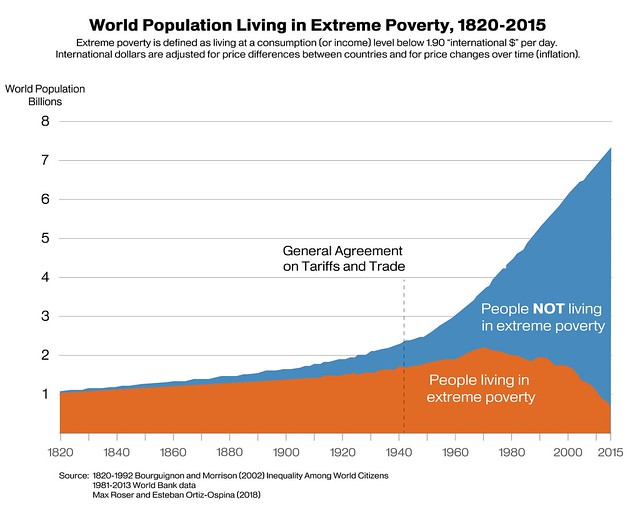
May is World Trade Month, a time to recognize and echo the importance of global trade, particularly fair trade. As we kickoff World Trade Month here at USDA, it’s important to acknowledge that trade is on our minds not only during May but every single day of the year. Our work supporting fair trade is a 24-hour job as few industries depend more upon – and benefit more from – trade than American agriculture.
It’s not an understatement to say that the gains from trade are powerful. When people produce what they are best at, and trade it for things they are less adept at producing, both sides benefit. Historically, economic integration in the post WWII era delivered immense benefits. Trade is not the only reason, but it is a major factor in helping the number of people living in extreme poverty fall to record lows and become dwarfed by the number of people not living in extreme poverty.
For U.S. agriculture, this success story is also a profitable one. Our farmers are the best in the world and we produce way more than we can consume. For many commodities, a significant share of U.S. production is exported. Without customers overseas, we would have huge surpluses, which would drive down prices, and result in hardships for our farmers that would ripple throughout the rural economy.
For me, these data raise two questions. First, since trade is good, what can we do to encourage more of it? Second, while trade is clearly good, how can we ensure it is fair? More specifically, while society as a whole benefits from access to foreign customers and the availability of imported goods, what can we do to protect particular industries from losing out to unfairly traded goods from foreign competitors? After working on trade policy for over 25 years, my view is that the answer to both of these questions is the same – a strong set of rules operated through a multilateral institution.
Importance of the WTO
Fortunately, we have a strong set of rules paired with an effective institution to both lay down rules for trade and enforce them – the World Trade Organization (WTO). WTO rules have been agreed to by 164 countries, including all the important trading nations, and have helped reduce barriers to trade that have powered the impressive growth in trade and expansion of world income. The core rules of the WTO are straight-forward and intuitively fair.
You may wonder how did these rules come about? Following the great depression and WWII, leaders in the United States recognized the importance of guarding against trade restrictions and wanted to expand trade to rebuild the world’s economies and foster closer diplomatic relations. Working initially with a small group of like-minded countries, a set of trade rules were agreed to in 1947, called the General Agreement on Tariffs and Trade (GATT). These rules were so successful that over time more countries joined the agreement, committing to follow the rules for trade among members of the GATT and also finding ways to negotiate reductions in trade barriers, principally tariffs. Building on this success, in 1994 the GATT was converted to the WTO, with further rules agreed to and, importantly, a binding dispute settlement system established.
The GATT, and now the WTO, have both helped expand trade and have established a set of rules that define ‘fair trade.’ So, what are those rules?
Story continued at: www.fas.usda.gov/newsroom/fair-trade-and-world-trade-organization



